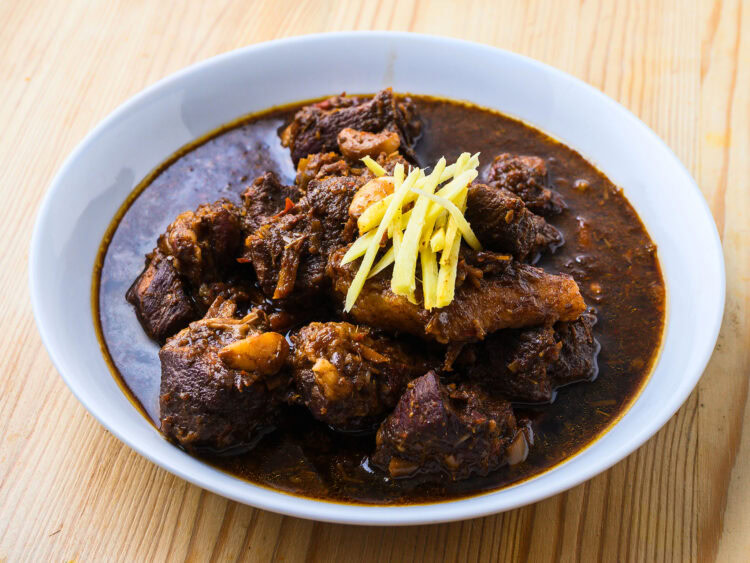A slow-cooked Thai Hang Lay curry, where tender pork soaks up fragrant spices and homemade curry paste.
Lift the lid off a pot of Gaeng Hang Lay. Aromas of ginger, tamarind, clove, and melting pork fat drift out. Unlike the coconut milk-rich curries most travelers know—like Thai red curry or Thai green curry—this northern Thai classic is built on Indian-inspired dry spices and the tang of pickled garlic.
A well-cooked Hang Lay finishes with a red oil sheen clinging to melting cubes of pork belly. The first spoonful is gentle, then sour, then subtly peppery—a progression so mild that “kids can eat it, adults love it,” as the local saying goes. History and ritual come together in every bite.
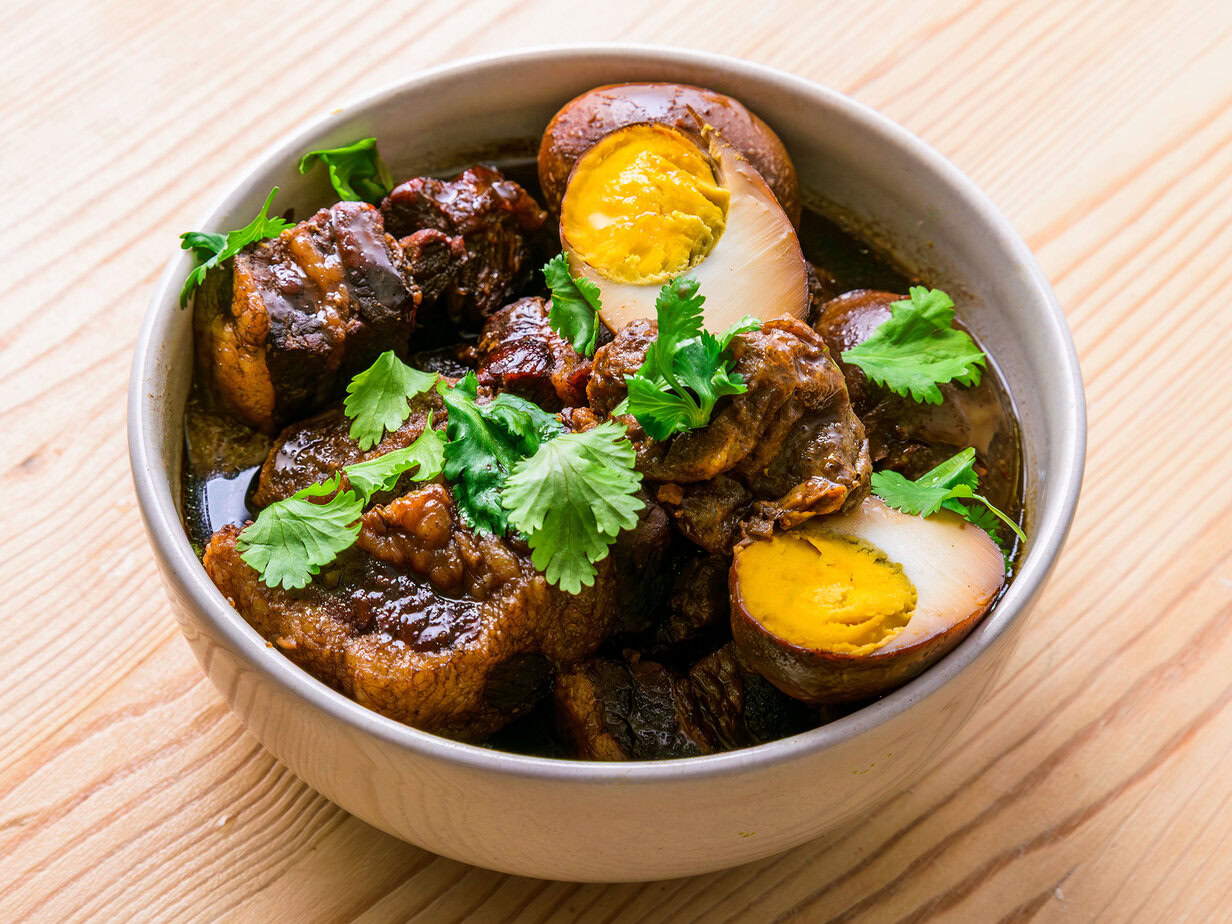
From Burmese Roots to Lanna Icon
The name itself hints at a journey. The Burmese hin hle (literally “heavy curry”) traveled from Myanmar with traders and soldiers, transforming into “hang lay.” Over centuries of contact—especially during the 18th-century Burmese rule—it settled into Lanna kitchens.
At first, it was just a stew of pork, salt, and dry spices. Northern cooks soon enriched it: lemongrass and galangal for fragrance, tamarind for brightness, a touch of cane sugar to soften the edges.
Archival recipes kept at Mahidol University still match those found in the markets: no coconut milk, a paste dominated by ginger pounded in a clay mortar, and always within reach, a packet of phong hang lay—the local masala. What began as an import has become a culinary landmark as iconic in the North as the teak temples scattered across its hills.
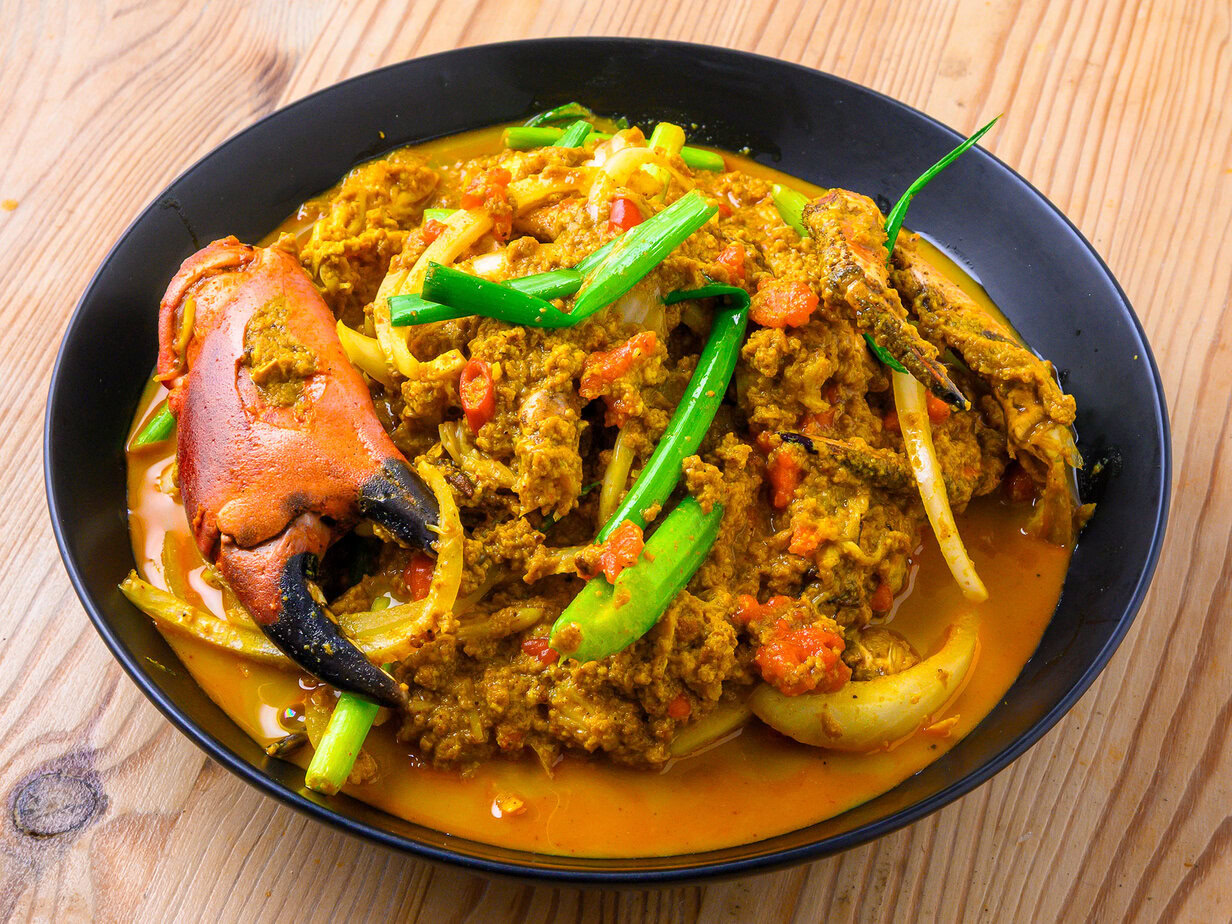
Festival Food & Community Feasts
Gaeng Hang Lay is made whenever life turns communal: merit-making days, khantok wedding dinners, or the morning the village pig is butchered.
Elders remember huge cauldrons left to simmer while neighbors wove sticky rice packets in banana leaves. The saying “one curry feeds the whole village” is no exaggeration: long simmering frees up the cooks for ceremonies while the flavors deepen.
At sunset, both monks’ alms bowls and family plates are filled with the same brick-red sauce—a shared taste of celebration.
The Flavor Map: Ingredients & Techniques
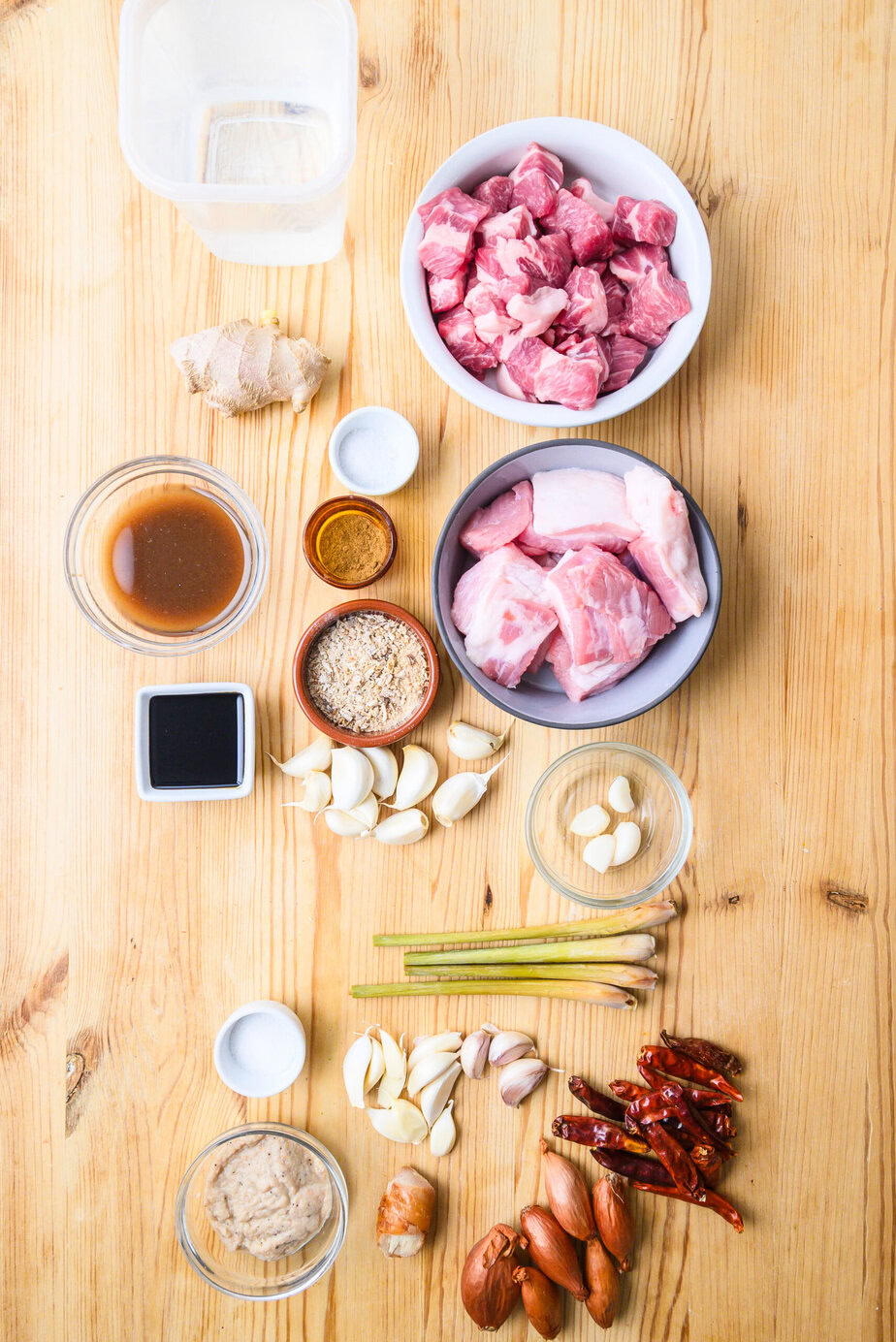
Every pot starts with two foundations. First comes the fresh paste: rehydrated dried chilies, lemongrass, galangal, turmeric, garlic, shallot, and a dab of shrimp paste. Everything is pounded until the oils bead on the mortar walls. Next goes in a handful of phong hang lay (cumin, coriander, clove, cinnamon, star anise, and other toasted spices).
Halfway through cooking—between the first and third hour—the “three friends” join the pot: crunchy ginger strips, whole garlic cloves, and syrupy-edged pickled garlic bulbs. A handful of roasted peanuts thickens the sauce and adds a buttery note.
Seasoning is a gradual process: palm sugar for sweetness, salt or a splash of fish sauce for depth, and sometimes a spoonful of tamarind to brighten the acidity. The goal is clear: the meat should fall apart under chopsticks, the sauce—thick as warm honey—should be topped with a translucent rust-colored oil: the chef’s signature.
At the Restaurant: How to Spot Real Gaeng Hang Lay
Browse Thai food forums and you’ll find heated debates dissecting the “rules” of Hang Lay.
Most cooks admit a packet of commercial seasoning can boost the flavor—but only as a backup to a hand-pounded paste; relying on it alone draws polite ridicule.
Traditionalists insist on time: a long simmer is essential. As for marinating, a few hours—ideally overnight—gives the best results. A pressure cooker might make the meat tender, but the aroma falls flat.
Ingredient swaps spark debate too: a mix of vinegar and sugar is tolerated if pickled garlic is hard to find; plum juice instead of tamarind is much less accepted, and anyone skipping shrimp paste is told to rename the dish.
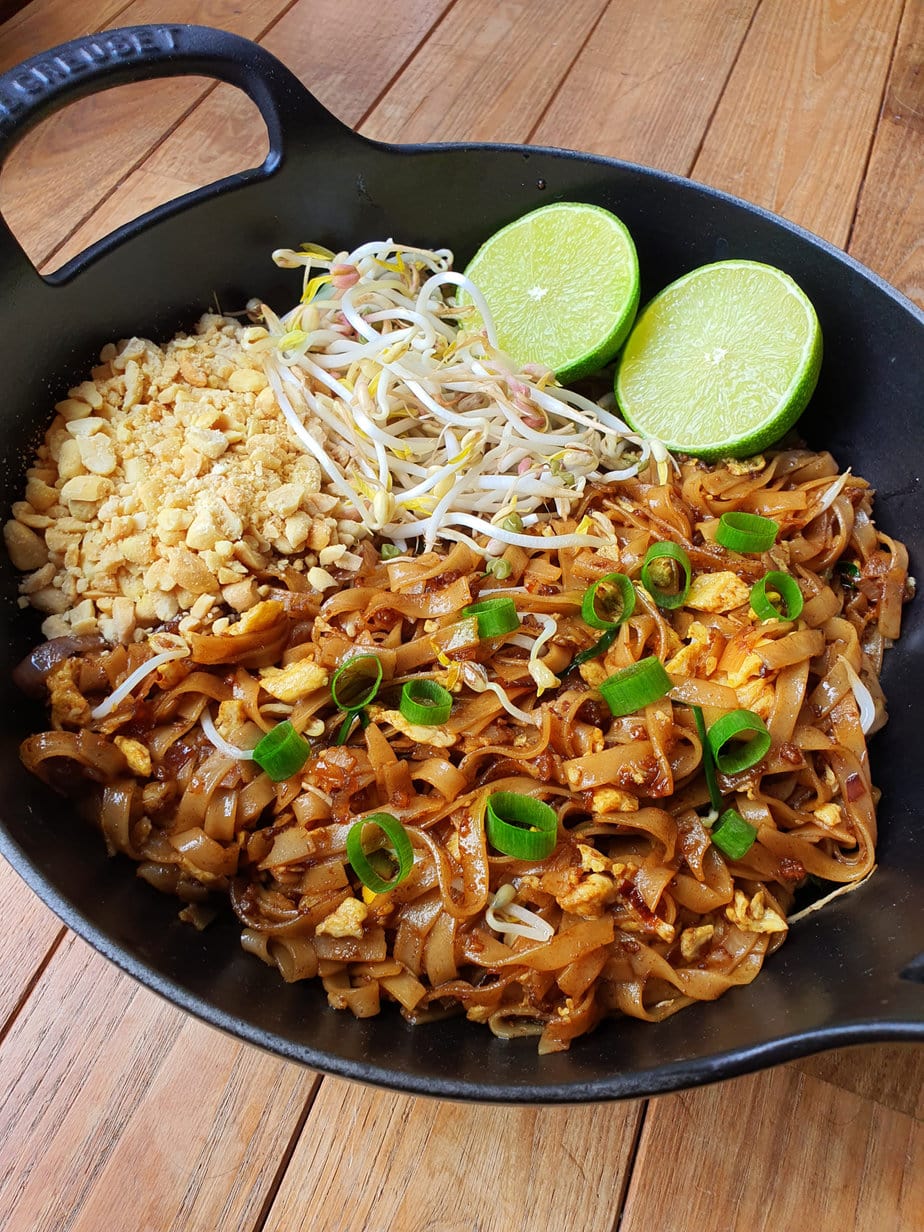
The Purists’ Essentials
No coconut milk or potatoes—those would turn the dish into a Massaman. A true Hang Lay must highlight ginger, feature a tamarind note, and hide tender pickled garlic cloves in every spoonful. The fresh herb paste and dry masala work together; even a single spoonful of generic curry powder is the ultimate red flag.
Across the North: Regional Styles & Family Secrets
In northern Thailand, the curry changes from province to province. The Burmese-style standard is thick, oily, and boldly salty-sour—little more than pork and spices.
In Chiang Saen, cooks add long beans, pickled bamboo, and toasted sesame, making the dish resemble the frugal stir-fry called gaeng ho. Chiang Mai palates lean sweeter, with extra palm sugar or syrup from pickled garlic, while Chiang Rai and Nan prefer a sharper tamarind tang and never skimp on peanuts.
Family notebooks add other twists: a slice of santol for fruitiness, a round of fermented soybean paste for funk, even chunks of pineapple to tenderize the meat. These variations prove the Thai saying “สูตรบ้านใครบ้านมัน” (“every house has its own recipe”).
How to Eat It
Sticky rice is the classic side for khantok dinners, but these days families often spoon the curry over jasmine rice. The next day, the flavors deepen even more; leftovers are shredded into a gaeng ho with glass noodles so not a drop of sauce goes to waste.
Modern chefs tempt city diners with a pinch of citrusy makhwaen pepper or a crown of crispy pork rinds, but the heart of the dish stays the same: as soon as the red oil rises and the ginger aroma lifts, the curry evokes northern Thai tradition more than any décor. The last bite blends spicy sweetness, a hint of tamarind, and the crunch of a slightly softened peanut.
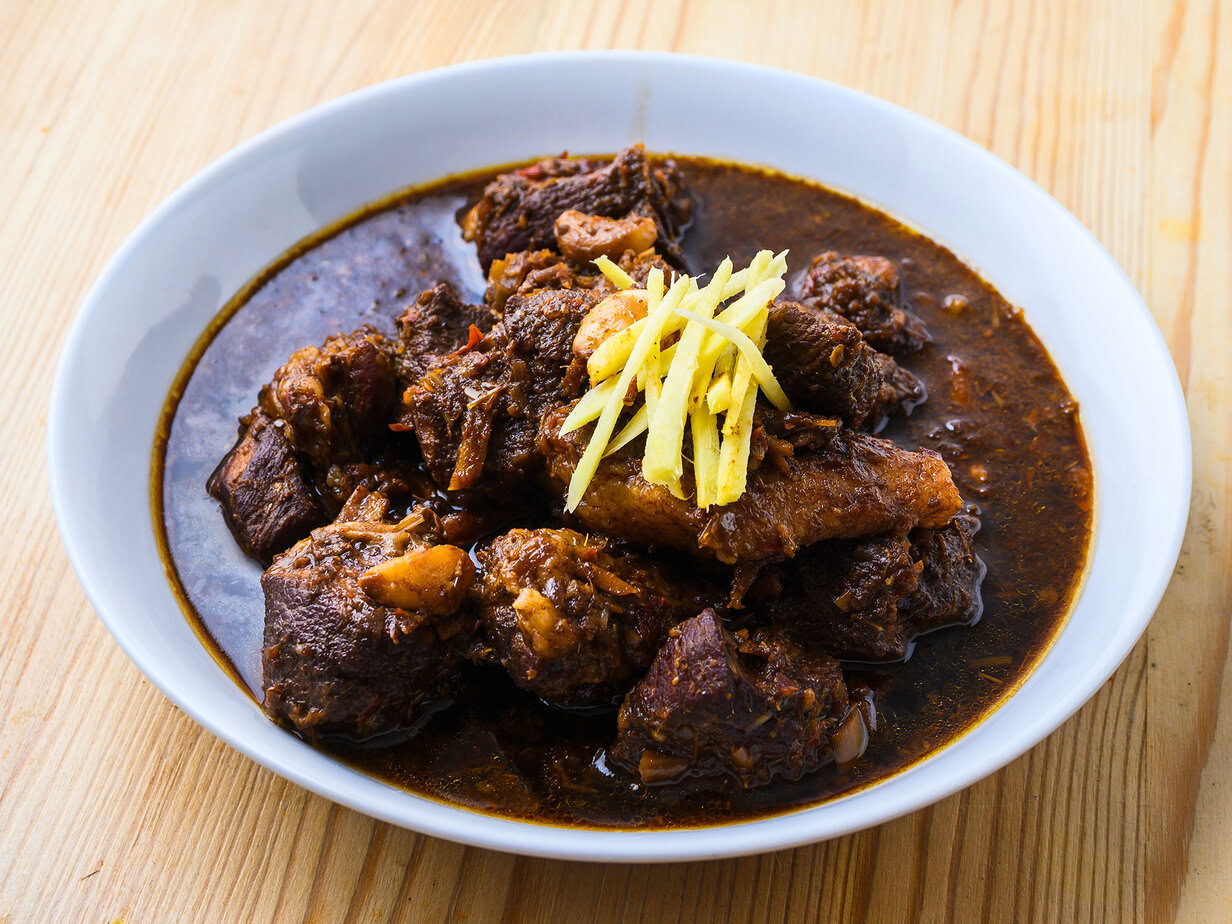
Ingredients
Main Curry
- 400 g pork belly cut into 5 cm cubes
- 400 g pork shoulder well-marbled, cut into 5 cm cubes
- 1 cup Hang Lay curry paste freshly pounded
- 2.5 liters water add gradually during braising
- 1 teaspoon salt
- 2 teaspoons Thai sweet dark soy sauce
- 3 tablespoons palm sugar
- 60 ml tamarind juice
- 4 cloves pickled garlic lightly crushed
- 2 tablespoons Hang Lay masala or substitute with garam masala
- 100 g ginger cut into matchsticks
- 20 cloves Thai garlic peeled; use only half the amount you would of regular garlic
Hang Lay Curry Paste
- 15 large dried red chilies seeded and soaked until softened
- 1 teaspoon salt
- 1 tablespoon galangal finely sliced
- 4 stalks lemongrass finely sliced
- 30 cloves Thai garlic use only half the amount you would of regular garlic
- 6 shallots thinly sliced
- 2 teaspoons shrimp paste (kapi)
For Serving
- Steamed sticky rice
Instructions
Curry Paste
- Pound the soaked chilies with the salt to a fine paste.15 large dried red chilies, 1 teaspoon salt
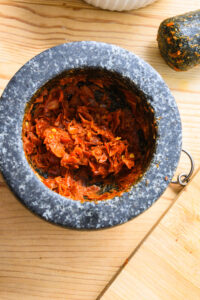
- Add the galangal and lemongrass, then pound until smooth.1 tablespoon galangal, 4 stalks lemongrass
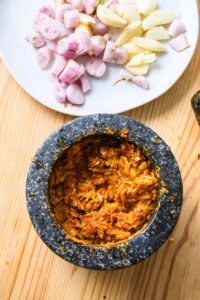
- Add the garlic, shallots, and shrimp paste, then pound to a smooth paste.30 cloves Thai garlic, 6 shallots, 2 teaspoons shrimp paste (kapi)
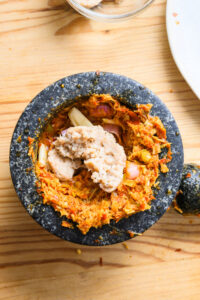
Pork
- Rinse the pork, then cut the pork belly and shoulder into 5 cm cubes.400 g pork belly, 400 g pork shoulder
- Place the curry paste in a large pot, add a splash of water, and stir to combine.1 cup Hang Lay curry paste, 2.5 liters water
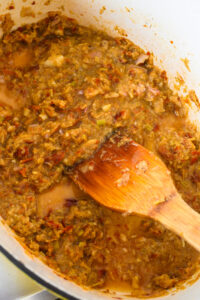
- Add the pork and cook over medium heat, stirring, for 3 minutes until the surfaces firm up.

- Gradually pour in the remaining water, then season with salt, Thai sweet dark soy sauce, palm sugar, and tamarind juice.1 teaspoon salt, 2 teaspoons Thai sweet dark soy sauce, 3 tablespoons palm sugar, 60 ml tamarind juice
- Add the pickled garlic, Hang Lay masala, ginger, and the whole Thai garlic cloves.4 cloves pickled garlic, 2 tablespoons Hang Lay masala, 100 g ginger, 20 cloves Thai garlic
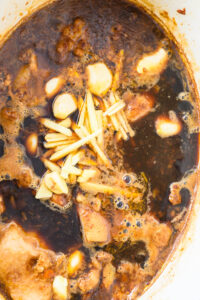
- Simmer very gently for 4 hours, adding water as needed, until the pork is meltingly tender and a red layer of fat rises to the top.

- Serve hot with steamed sticky rice.Steamed sticky rice
Notes
Nutrition
Culinary Sources
• Northern Thai Pork Curry, “Gaeng Hanglay” – ImportFood (English)
• Kaeng hang le – Wikipedia (English)
• “Everyone Has Their Own Recipe”: All the Variations of Kaeng Hang Le – KRUA.CO (Thai)
• Kaeng hang le, a Local Northern Dish: Where Did It Come From? – Lampang Info (Thai)
• Thai Menu – INMU, Mahidol University (Thai)
• Burmese Pork Curry with Ginger (Gaeng/Kaeng Hang Ley) – With a Glass (English)
• Gaeng Hang Lay Moo – Northern Thai Pork Belly Curry Recipe – Grantourismo Travels (English)
• Chiang Rai Database – Kaeng hang le – Google Sites (Thai)
• Hung Lay Curry… a Northern Thailand Specialty… – CarolCooks2 (English)
• Kaeng hang le from Chiang Saen, Thai Yuan Ethnic Cuisine – Local Food Discovery (Thai)
• Braised Pork Belly in Malaysian Curry (Gaeng Hung Lay) – Feral Cooks (English)
• Kaeng hang le, Traditional Northern Recipe – TikTok (Thai)
